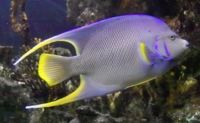Difference between revisions of "Holacanthus bermudensis"
From The Aquarium Wiki
| Line 37: | Line 37: | ||
}} | }} | ||
| − | == | + | {{Basic fish page |
| − | :Large angelfish with elongated dorsal and anal fins. Blue/brown body and the soft parts of dorsal and anal fins and caudal fins with wide yellow margins. The pelvic fins are bright yellow, and the pectorals are blue basally, clear distally, with a broad yellow band separating the two colours. | + | |Origin=:Western Atlanticic, from Bermuda, Bahamas and off southern Florida, USA to the Gulf of Mexico, including Yucatan, Mexico |
| + | |Sexing=:Difficult to tell as juveniles. Male adults are somewhat larger then females. | ||
| + | |diet=:It will take most foods including pellets, live and frozen foods. | ||
| + | |feeding_regime=:Feed once or twice a day. | ||
| + | |behaviour=:Compatible with most peaceful fish of equal size as a juvenile. As it grows, it will become more aggressive and territorial. | ||
| + | |identification=:Large angelfish with elongated dorsal and anal fins. Blue/brown body and the soft parts of dorsal and anal fins and caudal fins with wide yellow margins. The pelvic fins are bright yellow, and the pectorals are blue basally, clear distally, with a broad yellow band separating the two colours. | ||
| + | }} | ||
| + | |||
| + | ==Note== | ||
| + | :This species can hybridise with the [[Queen Angelfish]]. Resulting hybrids are called Townsend's Angelfish. | ||
Revision as of 01:12, 8 March 2018
Blue Angelfish
Holacanthus bermudensis
946 Litres (250 US G.)
40-45 cm (15.7-17.7")
8.1 - 8.4
22.2-25.6°C (72 -78 °F)
8-12 °d
1:1 M:F
10-20 years
Family
Pomacanthidae
| You can contribute to the Aquarium Wiki by expanding this article. Dont be shy!. |
Contents
Additional names
- Blue Angelfish, Bermuda Angelfish
Additional scientific names
- Holacanthus ciliaris bermudensis, Holacanthus isabelita, Angelichthys isabelita
Origin
|
|
This section requires expansion with: Location where this animal is found in the wild. |
Sexing
|
|
This section requires expansion with: Methods for differentiating male and females. |
Tank compatibility
|
|
This section requires expansion with: Other animals this species can be housed with, or animals they should not be housed with. |
Diet
- It will take most foods including pellets, live and frozen foods.
Feeding regime
- Feed once or twice a day.
Environment Specifics
|
|
This section requires expansion with: Anything the species requires to be comfortable in the tank, such as caves or grasses. |
Behaviour
- Compatible with most peaceful fish of equal size as a juvenile. As it grows, it will become more aggressive and territorial.
Identification
- Large angelfish with elongated dorsal and anal fins. Blue/brown body and the soft parts of dorsal and anal fins and caudal fins with wide yellow margins. The pelvic fins are bright yellow, and the pectorals are blue basally, clear distally, with a broad yellow band separating the two colours.
Note
- This species can hybridise with the Queen Angelfish. Resulting hybrids are called Townsend's Angelfish.
Pictures
External links
- Fishbase (Mirrors:
 )
)
